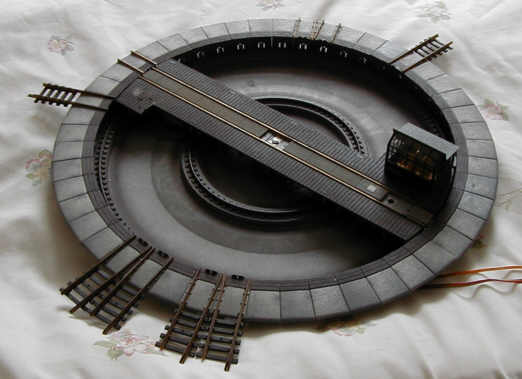
The turntable switch, when pushed to one extreme or the other, motors the turntable either clockwise or anticlockwise. When the switch is released, the turntable automatically aligns itself with the next angular position (which may contain a track exit or a blank). This guarantees that when the turntable bed reaches a track exit, the track exactly aligns; however it is the user's responsibility to get it to the vicinity of that exit in the first place.
The turntable is controlled by 5 wires which connect to the moving turntable bed through concentric slip rings. The function of the wires are:
| Wire | Function | Slip ring position |
| Red | Power to motor | Inner |
| Grey | Switch to start the "indexing" process | 2 |
| Yellow | Power to motor | 3 |
| Orange | Track power feed | 4 |
| Orange | Track power feed | Outer |
The turntable is motored clockwise or anticlockwise by applying constant 12v DC to the red and yellow wires (the DC polarity sets the direction). It moves until the turntable aligns with an angular "position" then stops. This is controlled by a mechanical switch on the turntable locating with a gear wheel, removing the power & locking the turntable in position. To restart motion, an external switch shorts the grey & yellow wires: this operates a small relay in the turntable & removes the mechanical lock. Once it has begun to move, it will continue until the next angular increment is reached even after the external switch has been released. It is this relay and mechanically operated switch that gives the turntable its "indexing" action.
The turntable motor, once in motion, requires approximately 50mA of current. The relay requires approximately 250mA but only for the short period while it is activated.
Automation using a DAC10 Accessory Decoder
Controlling the turntable from an accessory decoder so that it moves under DCC control to the next angular increment is not difficult. We have used a DAC10 accessory decoder to achieve this. The basic requirement is to use two accessory outputs as follows:
- One output provides continuous 12v power with polarity controlled by whether the accessory output is set to "thrown" or "closed";
- The other output is a momentary output, active for a short period whenever the throttle "closed" or "thrown" buttons are pressed.
The DAC10 allows one output to "follow" another. This allows the throttle to control the momentary output above using just one accessory address: the continuous output "follows" it and always sets itself to the same state. Therefore just one throttle action is needed.
A small adapter is needed to drive the turntable. turntableindexerschematic.pdf
The adaptor connects with J1 to DAC10 output 1, J2 to DAC10 output 2 and J3 to the turntable. It has two functions:
- It provides a high current, buffered power feed for the turntable motor: most accessory decoder outputs cannot provide a high current +12v feed as well as a high current 0v feed.
- It provides a relay, driven by the momentary accessory output, to switch the grey wire to the yellow one for a short period (0.5s) to initiate the process.
The DAC10 has been set up with the turntable controlled by outputs 1&2; it is activated by a throttle controlling output 2, with output 1 following automatically. Local inputs 1&2 have been set up to provide local "go left" and "go right" switch connections. The CV values used are:
| CV | Effect |
| CV3=47 | output 1 is continuously powered |
| CV4=3 | output 2 is a momentary output, active for 0.5s, no wait for capacitor discharge unit after each activation |
|
CV40=2 |
output 1 follows output 2 |
|
CV15=23; CV16=23 |
Inputs 1& 2 are positive edge triggered and control local routes |
| CV48=2; CV49=2 | Local route 1 sets point 2 to CLOSED |
| CV50=02;CV51=00 | Local route 2 sets point 2 to THROWN |
Finally the power jumpers for outputs 1&2 (JP1, JP2) are set into the "constant DC power feed" position: this is with the jumper closest to the board edge.
That's all there is to it: the DAC10 now controls clockwise and anticlockwise motion of the turntable. When set to "thrown" the turntable moves anticlockwise; when set to "closed" it moves clockwise. This can be initiated by a handheld throttle, by a DTM30 Tower Master panel, or by a computer application such as Winlok or Railroad&Co.


